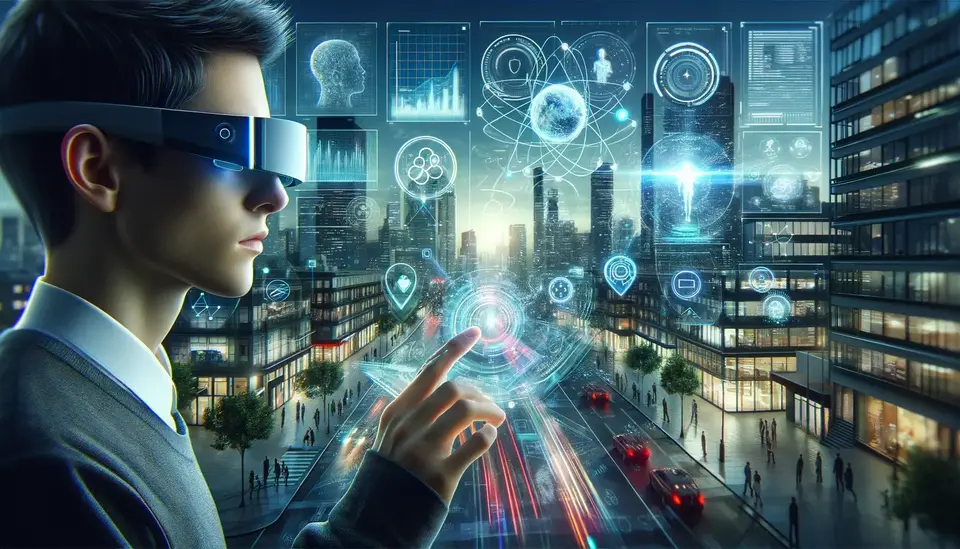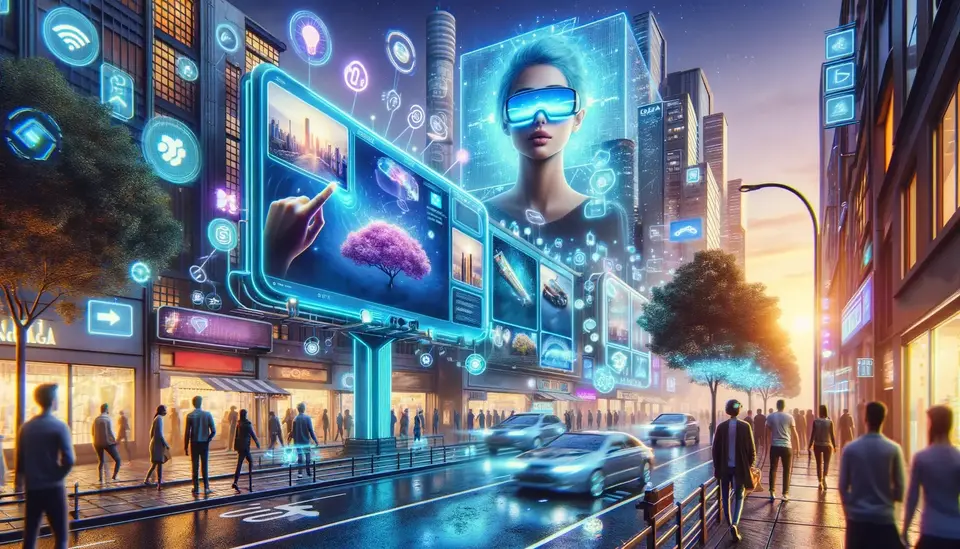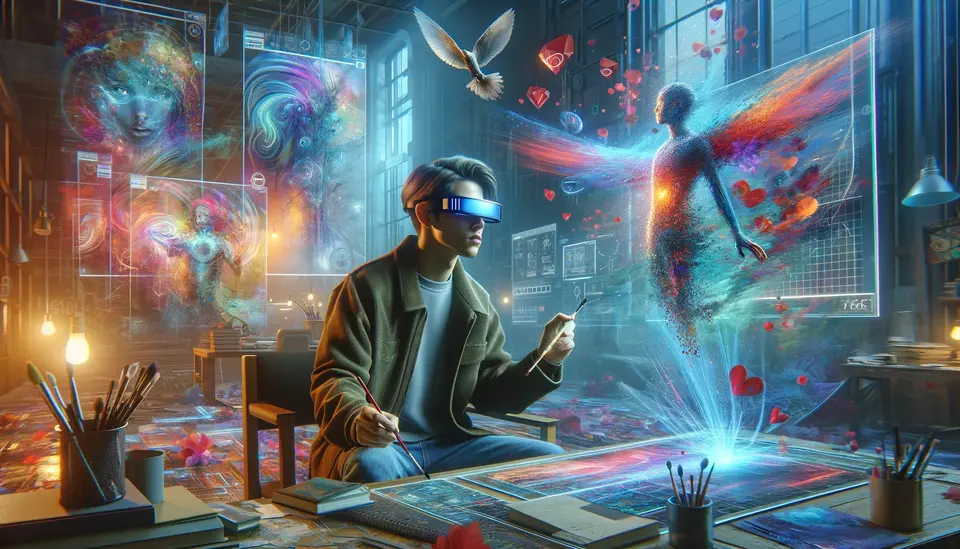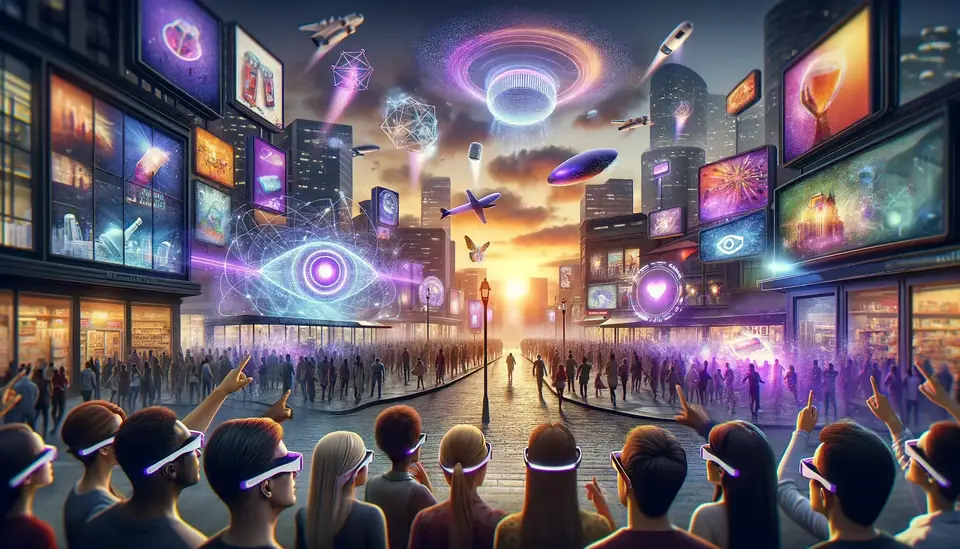The Role of Artificial Intelligence (AI) in Augmented Reality (AR)
Posted on February 3, 2024 9 minutes 1779 words
Table of contents
Introduction
In the rapidly evolving realm of technology, Augmented Reality (AR) stands out as a transformative force, seamlessly blending digital elements with the physical world. When paired with the prowess of Artificial Intelligence (AI), AR transcends beyond mere novelty, becoming a tool of unparalleled interactivity and utility. This fusion is revolutionizing how we perceive and interact with our surroundings, offering new dimensions to everyday experiences.
In this exploration, we delve into the profound impact of AI on AR, shedding light on how this synergy is not just enhancing user experiences but also reinventing the operational dynamics across various industries. From healthcare to education, retail to gaming, the infusion of AI into AR is setting new standards of innovation and interaction. As we embark on this journey, we aim to unravel the multifaceted role of AI in AR, providing insights into its current applications and a glimpse into the future of this symbiotic relationship.
AI and AR: Enhancing Real-World Interactions
The integration of Artificial Intelligence (AI) with Augmented Reality (AR) has been a game-changer in enhancing real-world interactions. AI adds a layer of intelligence to AR, making it possible for AR systems to understand and interact with the environment in more sophisticated ways.
- Contextual Understanding: AI algorithms enable AR systems to recognize and interpret objects, spaces, and scenarios in the real world. This deep understanding allows for more meaningful and relevant augmentations, providing users with a richer experience.
- Real-Time Adaptation: One of the most significant contributions of AI to AR is the ability to adapt in real-time. AR experiences can change dynamically based on the user’s environment, behavior, and even emotions, thanks to AI’s predictive and analytical capabilities.
- Enhanced Interaction and Engagement: AI-driven AR applications can interact with users in a more natural and intuitive way. Whether it’s through gesture recognition, voice commands, or personalized content, AI makes AR experiences more engaging and user-friendly.
Key Benefits:
- Personalized experiences tailored to individual preferences and behaviors.
- More intuitive and natural user interfaces.
- Realistic and context-aware augmentations that enhance the utility and appeal of AR applications.
By harnessing the power of AI, AR is not just overlaying digital information onto the real world; it is bringing about a more interactive, responsive, and personalized way of experiencing reality.
Transforming Industries: Real-World Applications
The convergence of Artificial Intelligence (AI) and Augmented Reality (AR) is not just a technological advancement; it’s a catalyst for transformation across various industries. Here are some compelling real-world applications demonstrating the impact of this fusion:
Education
- Interactive Learning: AI-driven AR creates interactive educational content, making learning more engaging. For instance, biology students can explore 3D models of human anatomy in real-time, enhancing their understanding and retention.
- Customized Learning Experiences: AI tailors AR experiences to individual learning styles and paces, providing a more personalized education.
Retail
- Virtual Try-Ons: Retailers are using AI-integrated AR for virtual try-ons, allowing customers to see how clothes, glasses, or makeup products would look on them through their smartphone screens, enhancing the online shopping experience.
- In-Store Navigation: AI-driven AR apps assist customers in navigating stores, providing information on products and offers in real-time, elevating the shopping experience.
Gaming
- Immersive Gaming: In gaming, AI in AR creates deeply immersive and interactive environments, adapting game scenarios and challenges based on the player’s behavior and preferences, offering a unique experience each time.
Healthcare
- Surgical Guidance: Surgeons are using AI-enhanced AR for real-time, in-surgery guidance, overlaying crucial information like imaging scans directly onto the patient’s body, improving precision and safety.
- Patient Education: AR applications, powered by AI, help in explaining complex medical conditions and treatments to patients, enhancing their understanding and engagement in their care.
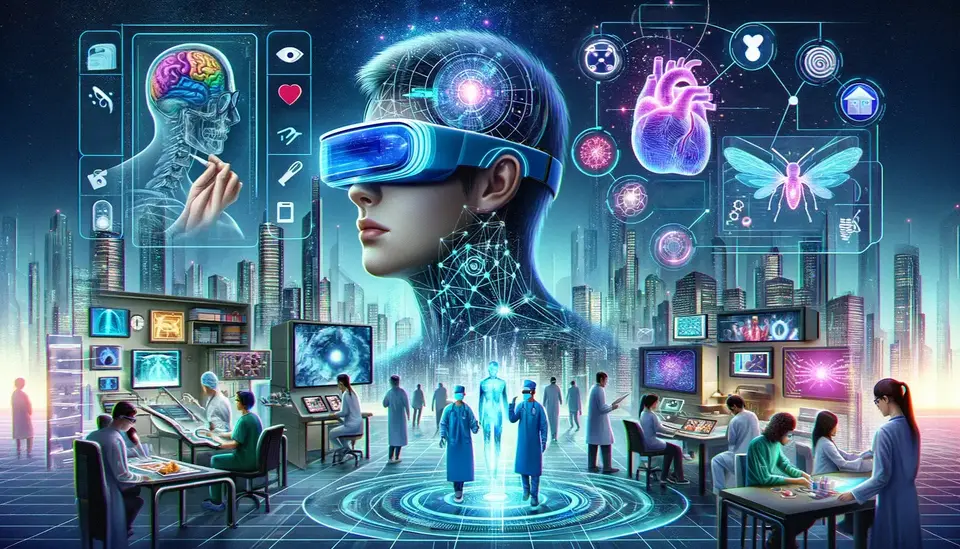
Key Impacts
- Improved accuracy and efficiency in healthcare procedures.
- Enhanced learning outcomes through interactive and personalized education.
- Elevated shopping experiences with personalized and convenient features.
- Innovative and engaging gaming experiences.
These applications showcase how AI-enhanced AR is not just a futuristic concept but a present-day reality, offering tangible benefits and transforming the way industries operate.
Emerging Technologies in AI for AR
The interplay of Artificial Intelligence (AI) and Augmented Reality (AR) is continually fueled by emerging technologies. These innovations not only enhance AR experiences but also broaden the spectrum of what’s possible in this domain.
- Computer Vision: At the heart of AI-driven AR is computer vision, enabling AR systems to accurately perceive and interpret the surrounding environment. This technology allows AR devices to recognize objects, faces, gestures, and even emotions, creating more interactive and personalized experiences.
- Machine Learning Algorithms: These algorithms are crucial in making AR experiences smarter and more adaptive. They analyze user data and behaviors, enabling AR systems to learn and evolve over time, providing more tailored and relevant content to the user.
- Predictive Analytics: AI’s ability to predict user behavior and preferences is transforming AR applications. Predictive analytics enables AR systems to anticipate what information or augmentation a user might need next, making the AR experience more intuitive and seamless.
- Spatial Computing: This emerging field combines the physical and digital worlds, enabling AR devices to understand and map the 3D space around the user. AI plays a vital role in this, processing spatial data to create more immersive and realistic AR experiences.
These technologies are not just enhancing current AR applications but are also paving the way for new possibilities. For instance, in the future, AR could be used for more advanced urban planning and navigation, interactive and immersive advertising, and even in creating smart workspaces that adapt to individual needs.
The continuous advancement in AI technologies promises to keep pushing the boundaries of AR, opening up a world where digital and physical realities coalesce seamlessly.
Challenges and Ethical Considerations
While the integration of Artificial Intelligence (AI) and Augmented Reality (AR) heralds many exciting possibilities, it also brings forth a set of challenges and ethical considerations that need careful navigation.
- Data Privacy and Security: As AI in AR often involves processing large amounts of personal data, including visual and spatial information, concerns around data privacy and security are paramount. Ensuring the protection of this sensitive data against unauthorized access and breaches is a major challenge.
- Accuracy and Reliability: The accuracy and reliability of AI-driven AR systems are critical, especially in high-stakes fields like healthcare and public safety. Misinterpretations or errors could lead to serious consequences, making the need for robust and error-proof systems essential.
- User Safety and Health: Prolonged use of AR can lead to physical side effects such as eye strain, fatigue, and in some cases, motion sickness. Ensuring user safety, particularly when AI-driven AR experiences are increasingly immersive, is a significant concern.
- Ethical Use of AI: The ethical implications of AI in AR, such as issues of consent, user manipulation, and the creation of realistic scenarios that may have psychological impacts, need careful consideration. There’s a fine line between enhancing experiences and infringing on personal and moral boundaries.
- Accessibility and the Digital Divide: The advanced technology required for AI-driven AR is not universally accessible, potentially widening the digital divide. Ensuring equitable access to these technologies is a challenge that needs addressing to avoid creating a gap between those with and without access to these advancements.
Navigating these challenges requires a collaborative approach involving technologists, ethicists, regulators, and users. Developing comprehensive standards, regulations, and ethical guidelines is crucial for the responsible advancement of AI in AR, ensuring that its benefits can be enjoyed broadly and safely.

The Future of AI in AR
As we gaze into the future, the potential of Artificial Intelligence (AI) in Augmented Reality (AR) continues to expand, promising to bring even more groundbreaking changes across various sectors and aspects of our daily lives.
- Enhanced Personalization and Interactivity: Future advancements in AI are expected to drive even higher levels of personalization and interactivity in AR experiences. Imagine AR systems that not only understand user preferences but also anticipate needs and adapt content in real-time, offering a truly customized experience.
- Broader Industrial and Commercial Applications: AI-enhanced AR is poised to transform industries far beyond its current scope. In manufacturing, AR can assist with complex assembly processes, while in retail, it could revolutionize customer experiences with highly interactive and personalized shopping environments.
- Integration with Emerging Technologies: The integration of AI in AR with other cutting-edge technologies like 5G, IoT (Internet of Things), and edge computing could lead to more seamless, efficient, and powerful AR experiences. This synergy is likely to enable faster processing, reduced latency, and more robust AR applications, even in complex environments.
- Social and Ethical Advancements: As we advance, a greater focus on social and ethical considerations in AI and AR development is anticipated. This includes enhanced privacy protections, ethical AI design, and efforts to make AR technology more accessible and inclusive, ensuring equitable benefits for all.
- Revolutionizing Everyday Life: The day is not far when AI-driven AR becomes an integral part of everyday life, from enhanced navigation systems and interactive educational tools to advanced personal assistants and immersive entertainment experiences.
The future of AI in AR is not just about technological advancements; it’s about redefining the way we interact with the world around us, enhancing our capabilities, and opening up new avenues for innovation and exploration.
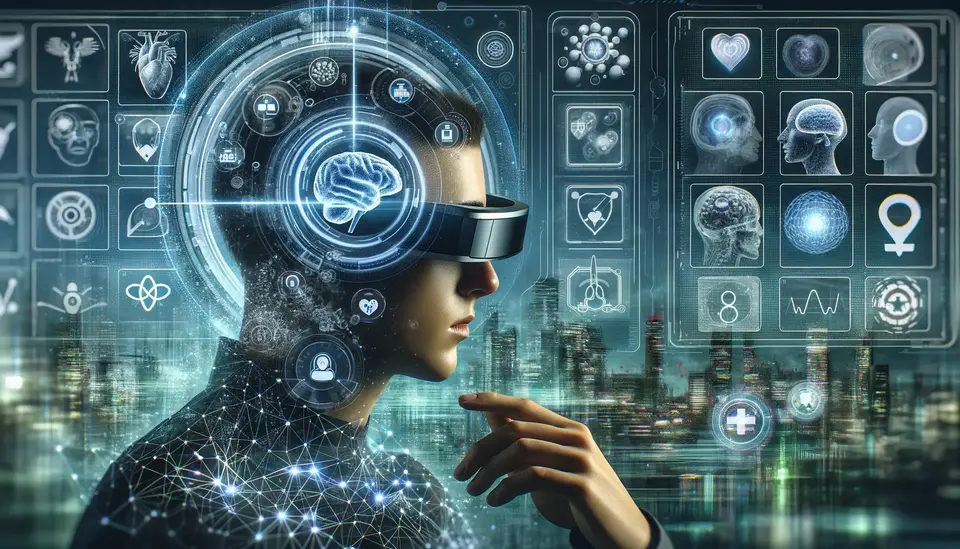
Conclusion and Key Takeaways
In this exploration of “Artificial Intelligence in Augmented Reality,” we have uncovered the profound impact and transformative potential of this synergy. AI not only enriches AR experiences but also propels them into new realms of possibility and application.
- Synergy of AI and AR: The integration of AI with AR has ushered in a new era of enhanced interaction and realism, making AR experiences more intuitive, personalized, and relevant.
- Diverse Industrial Impact: From healthcare and education to retail and entertainment, AI in AR is revolutionizing industry practices, offering innovative solutions, and improving user engagement and satisfaction.
- Emerging Technologies and Future Prospects: With ongoing advancements in technologies like computer vision and machine learning, the future of AI in AR holds immense promise. These advancements are poised to further revolutionize the way we work, learn, and interact with the world.
- Navigating Challenges: As we embrace these technologies, addressing the challenges and ethical considerations, including data privacy, user safety, and accessibility, is crucial for sustainable and responsible development.
- Shaping the Future: The journey of AI in AR is just beginning. As these technologies continue to evolve and intertwine, they hold the potential to redefine our reality, offering new ways to interact with and understand the world around us.
As we conclude, it’s clear that the fusion of AI and AR is not merely a technological trend but a pivotal shift in the digital landscape. It represents a future brimming with possibilities, inviting us all to engage, explore, and contribute to its evolution.

